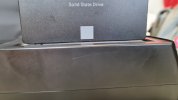You are using an out of date browser. It may not display this or other websites correctly.
You should upgrade or use an alternative browser.
You should upgrade or use an alternative browser.
Rate my battery?
- Thread starter PaulEden
- Start date
Mine is also but a little "less" than yours, mine is in storage and have check all the voltage in the cells and seems to be ok would like to hear the "big guns" comments?
would like to hear the "big guns" comments?
If you press on the “bubble” does it give way easily?This is one of my oldest batteries and has just finished charging.
Is it puffed?
Are you able to slide it in and out of the aircraft without it rubbing or binding?
Are the cells balanced in voltage and internal resistance?
If you answered yes to all three then they are most likely fine to use.
If the bubble gets hard, the battery starts rubbing or binding, or the cells don’t balance then it is time to retire that battery.
Yes to all your questions and still fly with it, thank you (My comment)If you press on the “bubble” does it give way easily?
Are you able to slide it in and out of the aircraft without it rubbing or binding?
Are the cells balanced in voltage and internal resistance?
If you answered yes to all three then they are most likely fine to use.
If the bubble gets hard, the battery starts rubbing or binding, or the cells don’t balance then it is time to retire that battery.
The bubble isn't hard. I can press it with only a little pressure.
How can I check the balance and resistance? I have a multimeter.
How can I check the balance and resistance? I have a multimeter.
The bubble is very slight, it doesn't protrude beyond the case or rub on the aircraft.The bubble isn't hard. I can press it with only a little pressure.
How can I check the balance and resistance? I have a multimeter.
Paul,
You can check the voltage balance quite easily using a multimeter. The attached file shows an H480 battery, but the same scheme is used on the H Plus battery where the balance contacts are mini Dean’s instead of the round contacts.
You can google methods to measure IR of the battery cells using a multimeter and a known load, but it is better to use a quality third party charger that can give you cell voltages and IR readings, as well as, do balance charging and place packs at storage level.
Tenergy has a small battery tester that is okay for cell voltages, but the IR measurement was badly defective on two that I tried and their tech support was useless. In both the first and last cells always measured excessively high and the middle cells were lower than normal. Suggests to me there is a design issue that needs to be addressed.
You can check the voltage balance quite easily using a multimeter. The attached file shows an H480 battery, but the same scheme is used on the H Plus battery where the balance contacts are mini Dean’s instead of the round contacts.
You can google methods to measure IR of the battery cells using a multimeter and a known load, but it is better to use a quality third party charger that can give you cell voltages and IR readings, as well as, do balance charging and place packs at storage level.
Tenergy has a small battery tester that is okay for cell voltages, but the IR measurement was badly defective on two that I tried and their tech support was useless. In both the first and last cells always measured excessively high and the middle cells were lower than normal. Suggests to me there is a design issue that needs to be addressed.
Attachments
h-elsner
Premium Pilot
- Joined
- Mar 23, 2016
- Messages
- 1,949
- Reaction score
- 1,643
- Location
- Bavaria / Germany
- Website
- h-elsner.mooo.com
All you need is a load, a lamp or a resistor. You can measure cell voltage without load but this is not really helpful. Cell voltage can be measured on the balancer pins.How can I check the balance and resistance? I have a multimeter.
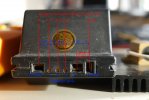
My load (intensionally made to test computer power supply):
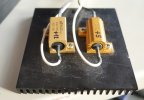
Internal resistance is voltage w/o load - voltage with load / load current.
Example: Without load we have 4.2V per cell, we drain 2A and the voltage drops down to 4.05V. Diff is 150mV / 2A = 75mOhm --> cell is dead.
For both, voltage and current you can use your multimeter.
To approximate the healty of your battery you can use the telemetry data from flightlog. For me this is a part of post-flight checks.
Battery mAh ratings... anyway for us to test it?
As many other users have noted over the years, there seems to be any number of mAh ratings that manufactures place on the labels of their batteries. It is generally understood that a higher mAh rating will usually give a longer flight time. But, this must also take into consideration any...
br HE
7cyclops
Premium Pilot
I also used a tenergy to try and measure IR and get a very different reading every time,all on same battery same cells etc. and sometimes way off the charts. Junk, I agree. Have a great charger does all but IR. Need a meter just for IR also. Any suggestions ? KCPaul,
You can check the voltage balance quite easily using a multimeter. The attached file shows an H480 battery, but the same scheme is used on the H Plus battery where the balance contacts are mini Dean’s instead of the round contacts.
You can google methods to measure IR of the battery cells using a multimeter and a known load, but it is better to use a quality third party charger that can give you cell voltages and IR readings, as well as, do balance charging and place packs at storage level.
Tenergy has a small battery tester that is okay for cell voltages, but the IR measurement was badly defective on two that I tried and their tech support was useless. In both the first and last cells always measured excessively high and the middle cells were lower than normal. Suggests to me there is a design issue that needs to be addressed.
The most reliable method I've found to check battery condition is with the Yuneec A10 battery charger. It measures cell voltage and internal resistance. It's fairly consistent. When measuring IR with any meter you will find it varies from one day to the next. It's is the range that is important and any cell that varies widely from the other cells is a warning sign.
In the 1st pic below the batteries on the left have a high IR. The ones on the right are nearly perfect.
I record the numbers on the back of the battery to keep track of changes.
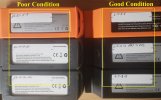
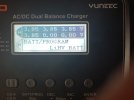
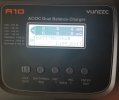
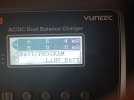
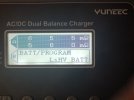
In the 1st pic below the batteries on the left have a high IR. The ones on the right are nearly perfect.
I record the numbers on the back of the battery to keep track of changes.





I haven't tested the battery as suggested. My multimeter is dead and hasn't been replaced. Something else odd has happened. I got stuck with charged batteries because the weather turned before I could fly yesterday. This morning, between storms, I was just flying low level along my road to try and burn off some charge. I had been maneuvering for about 5 minutes when the weather went bad again so we landed, shut down and came indoors. Once inside, I powered up tge drone and controller to see how much power used up, but the controller reported the drone at 99% battery! Is this normal
It will recover once current draw is reduced. That is called rebound. If you start the motors you will see the percentage drop faster than normal. With the H+ it is harder to see that because the motors disarm after 10 to 15 seconds without launching.I haven't tested the battery as suggested. My multimeter is dead and hasn't been replaced. Something else odd has happened. I got stuck with charged batteries because the weather turned before I could fly yesterday. This morning, between storms, I was just flying low level along my road to try and burn off some charge. I had been maneuvering for about 5 minutes when the weather went bad again so we landed, shut down and came indoors. Once inside, I powered up tge drone and controller to see how much power used up, but the controller reported the drone at 99% battery! Is this normal
As long as the battery is not rubbing when inserted, it does not necessarily need to be retired entirely. It can still be used for non-flight operations, such as calibrations or sitting to update the GPS satellite almanac.
Just be sure to clearly label the battery as "non-flight". This way you can maximize your other batteries for actual flight cycles.
Just be sure to clearly label the battery as "non-flight". This way you can maximize your other batteries for actual flight cycles.
Ah right, that makes sense, thank you. At the moment, the drone is sitting on the table with the camera on (not motors, obv) and it's draining slowly. That method will; have to do for now.It will recover once current draw is reduced. That is called rebound. If you start the motors you will see the percentage drop faster than normal. With the H+ it is harder to see that because the motors disarm after 10 to 15 seconds without launching.
No, it doesn't rub. I flew it this morning without incident, though it was just a 'discharge' flight. Quite low level and back and forth.As long as the battery is not rubbing when inserted, it does not necessarily need to be retired entirely. It can still be used for non-flight operations, such as calibrations or sitting to update the GPS satellite almanac.
Just be sure to clearly label the battery as "non-flight". This way you can maximize your other batteries for actual flight cycles.
Similar threads
- Replies
- 4
- Views
- 693
- Replies
- 5
- Views
- 508




